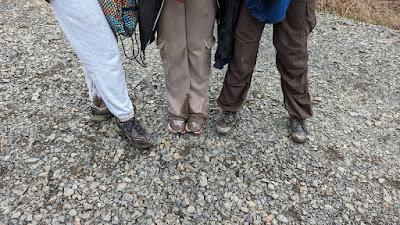We got even more volunteers out this weekend to work on the Paugussett Trail than last weekend.
This picture doesn't do it justice because this was the clean version at the beginning. A number of High School students kept rolling in all morning as we kept working.
We had issues with the finer crushed stone sinking into the muck last week so this week we got the Shelton Highways and Bridges Dept. to drop off some coarser stone to firm up the base, and then top it off with the finer mix. We had a great teams moving the stone with wheelbarrows and buckets.
Plenty of team work.
Tom Welch actually read the Work Party Instructions saying "wear your worst work clothes, because they will get muddy". And his old shoe started to come apart. Luckily we had duct tape, lots and lots of duct tape, which made for some funny moments, but Tom left the work party with the same number of shoes that he arrived with.
Everybody finished up with muddy feet at the end. But we got a few more hundred feet into the woods. The next work party should finish it up for this section.
Thanks to Teresa, Patrick, Tom, Ethan, Ryan, Allison, Zach, Zion, Jack, Emily, Analia, Kassidy, Maya, Jadelyn, Erik, Luis, Ted, Devin, Dillon, and Terry for helping out. Sorry if anyone's name is missing or misspelled. The start of the work party was kinda like the opening of JRR Tolkien's The Hobbit when all the dwarfs kept arriving for dinner. But all the help was wonderful.






























